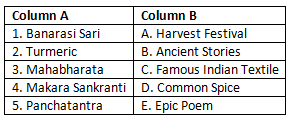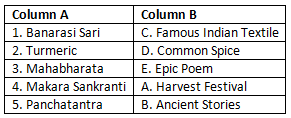Worksheet Solutions: Unity in Diversity or 'Many in the One' | Worksheets with Solutions for Class 6 PDF Download
| Table of contents |

|
| Multiple Choice Questions |

|
| Fill in the Blanks |

|
| True or False |

|
| Match the Following |

|
Multiple Choice Questions
Q1: Which of the following is a common staple grain in India?
(a) Corn
(b) Wheat
(c) Cotton
(d) Oats
Ans: (b) Wheat
Wheat – It is one of India’s main staple grains, especially in northern states. Corn is grown but is not as widely consumed.
Q2: What is the primary material used to make traditional saris?
(a) Wool
(b) Silk
(c) Cotton
(d) Jute
Ans: (b) Silk
Silk – Traditional saris are often made from silk, prized for its shine and softness. Cotton and wool saris exist but are less formal.
Q3: Which festival marks the beginning of the harvest season in India?
(a) Diwali
(b) Makara Sankranti
(c) Holi
(d) Eid
Ans: (b) Makara Sankranti
Makara Sankranti – This festival marks the harvest season in India, celebrated in January with regional variations.
Q4: The Panchatantra is originally written in which language?
(a) Hindi
(b) Bengali
(c) Sanskrit
(d) Tamil
Ans: (c) Sanskrit
Sanskrit – The Panchatantra, a collection of animal fables with moral lessons, was originally written in Sanskrit.
Q5: Which of these is NOT a type of silk sari?
(a) Banarasi
(b) Kanjivaram
(c) Chintz
(d) Mysore
Ans: (c) Chintz
Chintz – Chintz is a printed cotton fabric, not a silk sari; Banarasi, Kanjivaram, and Mysore are well-known types of silk saris.
Fill in the Blanks
Q1: The ________ is a long piece of cloth traditionally worn by women in India.
Ans: sari
Q2: Common spices used in Indian cooking include ________, cumin, and ginger.
Ans: turmeric
Q3: The two great Indian epics are the ________ and the Mahabharata.
Ans: Ramayana
Q4: Indian textiles were historically famous for producing ________ cotton.
Ans: best
Q5: The ________ project surveyed 4,635 communities across India.
Ans: People of India
True or False
Q1: The sari is an unstitched garment.
Ans: True
Q2: All Indian languages use the same script.
Ans: False
Q3: The Panchatantra has been adapted into many languages.
Ans: True
Q4: Chintz was popular in 17th-century Europe.
Ans: True
Q5: The Mahabharata is a short story.
Ans: False
Match the Following
 Ans:
Ans:
FAQs on Worksheet Solutions: Unity in Diversity or 'Many in the One' - Worksheets with Solutions for Class 6
| 1. What is the meaning of "Unity in Diversity" in the context of culture? |  |
| 2. How does "Unity in Diversity" manifest in everyday life? |  |
| 3. What are some historical examples of "Unity in Diversity"? |  |
| 4. Why is "Unity in Diversity" important for societal progress? |  |
| 5. How can individuals contribute to "Unity in Diversity"? |  |
















